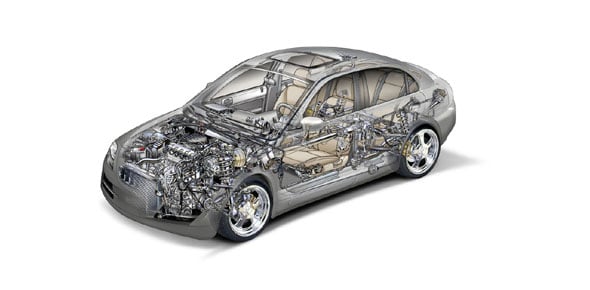Automotive Systems, Quiz Yourself 5

Two-stroke-cycle Engine.
Questions and Answers
- 1.
The four events in a two-stroke-cycle engine are:
- A.
Compression, power, intake, exhaust
- B.
Intake, power, compression, exhaust
- C.
Intake, compression, power, exhaust
Correct Answer
C. Intake, compression, power, exhaustExplanation
In a two-stroke-cycle engine, the correct order of events is intake, compression, power, and exhaust. During the intake stroke, the fuel-air mixture is drawn into the cylinder. In the compression stroke, the mixture is compressed to increase its pressure and temperature. The power stroke is when the spark plug ignites the mixture, causing an explosion that drives the piston down. Finally, in the exhaust stroke, the burned gases are expelled from the cylinder. This sequence of events allows for efficient combustion and power generation in a two-stroke-cycle engine.Rate this question:
-
- 2.
How many events does a diesel engine have to complete one cycle of operation?
- A.
Six
- B.
Eight
- C.
Three
Correct Answer
A. SixExplanation
A diesel engine completes one cycle of operation in six events. These events include intake, compression, combustion, expansion, exhaust, and scavenging. During the intake event, air is drawn into the engine. In the compression event, the air is compressed. Combustion occurs when fuel is injected and ignited, leading to the expansion event. The exhaust event involves the expulsion of waste gases. Finally, in the scavenging event, fresh air is introduced to clear out any remaining exhaust gases. Therefore, a diesel engine requires six events to complete one cycle of operation.Rate this question:
-
- 3.
How many power strokes are produced by one revolution of the crankshaft in a two-stroke-cycle engine?
- A.
Four
- B.
Two
- C.
One
Correct Answer
C. OneExplanation
In a two-stroke-cycle engine, one revolution of the crankshaft produces only one power stroke. This is because the two-stroke-cycle engine completes both the intake and exhaust strokes in the same revolution as the compression and power strokes. Therefore, the piston fires and generates power only once per revolution of the crankshaft.Rate this question:
-
- 4.
Does a two-stroke-cycle engine produce more power than a four-stroke-cycle engine?
- A.
Yes
- B.
No
- C.
Maybe
Correct Answer
A. YesExplanation
A two-stroke-cycle engine does produce more power than a four-stroke-cycle engine. This is because a two-stroke engine completes a power cycle in just two strokes of the piston (one upstroke and one downstroke), while a four-stroke engine requires four strokes (intake, compression, power, and exhaust). The shorter time required for the power cycle in a two-stroke engine allows it to produce power more frequently, resulting in higher power output compared to a four-stroke engine.Rate this question:
-
- 5.
A two-stroke-cycle engine produces less power per stroke than a four-stroke-cycle engine because it has less ---
- A.
Air
- B.
Fuel
- C.
Volume
Correct Answer
A. AirExplanation
A two-stroke-cycle engine produces less power per stroke than a four-stroke-cycle engine because it has less air. In a two-stroke engine, the air-fuel mixture is compressed and ignited in every revolution of the engine, resulting in a quicker combustion process. This means that there is less time for the air to enter the cylinder, resulting in a lower volume of air available for combustion. As a result, the engine produces less power per stroke compared to a four-stroke engine, which allows more time for the air to enter the cylinder and achieve a higher volume of air for combustion.Rate this question:
-
- 6.
What does the two-stroke-cycle engine require that the four-stroke-cycle engine does not?
- A.
Exhaust valve
- B.
Boiler
- C.
Blower
Correct Answer
C. BlowerExplanation
The two-stroke-cycle engine requires a blower, which is not needed in a four-stroke-cycle engine. The blower helps in the process of scavenging, where fresh air-fuel mixture is forced into the combustion chamber and exhaust gases are expelled. This is necessary because in a two-stroke-cycle engine, the intake and exhaust processes occur simultaneously, while in a four-stroke-cycle engine, they occur in separate strokes. Therefore, the blower is essential for the proper functioning of a two-stroke-cycle engine.Rate this question:
-
Quiz Review Timeline +
Our quizzes are rigorously reviewed, monitored and continuously updated by our expert board to maintain accuracy, relevance, and timeliness.
-
Current Version
-
Mar 21, 2023Quiz Edited by
ProProfs Editorial Team -
Sep 11, 2012Quiz Created by
Sandybridge
- Accounting Quizzes
- Advertising Quizzes
- Agriculture Quizzes
- Brand Quizzes
- Business Accounting Quizzes
- Business Analyst Quizzes
- Business Development Quizzes
- Business Environment Quizzes
- Business Etiquette Quizzes
- Business Finance Quizzes
- Business Math Quizzes
- Business Organization Quizzes
- Business Plan Quizzes
- Business Process Quizzes
- Business Study Quizzes
- Business Technology Quizzes
- CEO Quizzes
- Collaboration Quizzes
- Company Quizzes
- Construction Quizzes
- Consumer Quizzes
- CSR Quizzes
- Customer Quizzes
- Customer Service Quizzes
- Development Quizzes
- Ecommerce Quizzes
- Employment Quizzes
- Entrepreneurship Quizzes
- Finance Quizzes
- Hospitality Quizzes
- Human Resources Quizzes
- Industry Quizzes
- International Business Quizzes
- Introduction To Business Quizzes
- Investment Quizzes
- Logistics Quizzes
- Management Quizzes
- Manufacturing Quizzes
- Marketing Quizzes
- Material Quizzes
- Media Quizzes
- Office Quizzes
- Organization Quizzes
- Principles Of Business Quizzes
- Printing Quizzes
- Product Quizzes
- Publishing Quizzes
- Real Estate Quizzes
- Retail Quizzes
- Sales Quizzes
- SAP Business One Quizzes
- Small Business Quizzes
- Source Quizzes
- Supply Quizzes
- Survey Quizzes
- Telecommunication Quizzes
- Trade Quizzes
- Training Quizzes
- Warehouse Quizzes
- Welding Quizzes
 Back to top
Back to top


